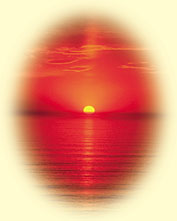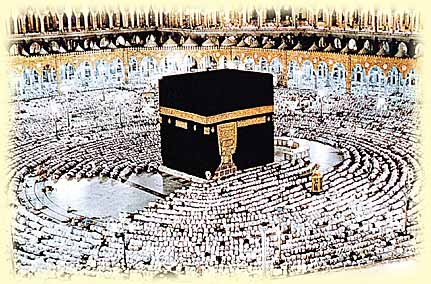The Five Pillars of Islam are the framework of the Muslim life. They are the testimony of faith, prayer, givingzakat (support of the needy), fasting during the month of Ramadan, and the pilgrimage to Makkah once in a lifetime for those who are able.
|
1) The Testimony of Faith:
The testimony of faith is saying with conviction, “La ilaha illa Allah, Muhammadur rasoolu Allah.” This saying means “There is no true god (deity) but God (Allah), and Muhammad is the Messenger (Prophet) of God.” The first part, “There is no true god but God,” means that none has the right to be worshipped but God alone, and that God has neither partner nor son. This testimony of faith is called the Shahada, a simple formula which should be said with conviction in order to convert to Islam (as explained previously on this page). The testimony of faith is the most important pillar of Islam.
2) Prayer:
Muslims perform five prayers a day. Each prayer does not take more than a few minutes to perform. Prayer in Islam is a direct link between the worshipper and God. There are no intermediaries between God and the worshipper.
In prayer, a person feels inner happiness, peace, and comfort, and that God is pleased with him or her. The Prophet Muhammad  said: {Bilal, call (the people) to prayer, let us be comforted by it.} Bilal was one of Muhammad’s
said: {Bilal, call (the people) to prayer, let us be comforted by it.} Bilal was one of Muhammad’s  companions who was charged to call the people to prayers.
companions who was charged to call the people to prayers.
Prayers are performed at dawn, noon, mid-afternoon, sunset, and night. A Muslim may pray almost anywhere, such as in fields, offices, factories, or universities.
(For detailed information on how to perform prayer, please refer to the links at How to Perform Prayer or refer to the book entitled A Guide to Salat (Prayer) by M. A. K. Saqib.3)
3) Giving Zakat (Support of the Needy):
All things belong to God, and wealth is therefore held by human beings in trust. The original meaning of the word zakat is both ‘purification’ and ‘growth.’ Giving zakatmeans ‘giving a specified percentage on certain properties to certain classes of needy people.’ The percentage which is due on gold, silver, and cash funds that have reached the amount of about 85 grams of gold and held in possession for one lunar year is two and a half percent. Our possessions are purified by setting aside a small portion for those in need, and, like the pruning of plants, this cutting back balances and encourages new growth.
The original meaning of the word zakat is both ‘purification’ and ‘growth.’ Giving zakatmeans ‘giving a specified percentage on certain properties to certain classes of needy people.’ The percentage which is due on gold, silver, and cash funds that have reached the amount of about 85 grams of gold and held in possession for one lunar year is two and a half percent. Our possessions are purified by setting aside a small portion for those in need, and, like the pruning of plants, this cutting back balances and encourages new growth.
 The original meaning of the word zakat is both ‘purification’ and ‘growth.’ Giving zakatmeans ‘giving a specified percentage on certain properties to certain classes of needy people.’ The percentage which is due on gold, silver, and cash funds that have reached the amount of about 85 grams of gold and held in possession for one lunar year is two and a half percent. Our possessions are purified by setting aside a small portion for those in need, and, like the pruning of plants, this cutting back balances and encourages new growth.
The original meaning of the word zakat is both ‘purification’ and ‘growth.’ Giving zakatmeans ‘giving a specified percentage on certain properties to certain classes of needy people.’ The percentage which is due on gold, silver, and cash funds that have reached the amount of about 85 grams of gold and held in possession for one lunar year is two and a half percent. Our possessions are purified by setting aside a small portion for those in need, and, like the pruning of plants, this cutting back balances and encourages new growth.
A person may also give as much as he or she pleases as voluntary alms or charity.
4) Fasting the Month of Ramadan:
 Every year in the month of Ramadan, all Muslims fast from dawn until sundown, abstaining from food, drink, and sexual relations.
Every year in the month of Ramadan, all Muslims fast from dawn until sundown, abstaining from food, drink, and sexual relations.
Although the fast is beneficial to health, it is regarded principally as a method of spiritual self-purification. By cutting oneself off from worldly comforts, even for a short time, a fasting person gains true sympathy with those who go hungry, as well as growth in his or her spiritual life.
5) The Pilgrimage to Makkah:
The annual pilgrimage (Hajj) to Makkah is an obligation once in a lifetime for those who are physically and financially able to perform it. About two million people go to Makkah each year from every corner of the globe. Although Makkah is always filled with visitors, the annualHajj is performed in the twelfth month of the Islamic calendar. Male pilgrims wear special simple clothes which strip away distinctions of class and culture so that all stand equal before God.
 |
Pilgrims praying at the Haram mosque in Makkah. In this mosque is the Kaaba (the black building in the picture) which Muslims turn toward when praying. The Kaaba is the place of worship which God commanded the Prophets Abraham and his son, Ishmael, to build.
|
The rites of the Hajj include circling the Kaaba seven times and going seven times between the hillocks of Safa and Marwa, as Hagar did during her search for water. Then the pilgrims stand together in Arafa5 and ask God for what they wish and for His forgiveness, in what is often thought of as a preview of the Day of Judgment.
The end of the Hajj is marked by a festival, Eid Al-Adha, which is celebrated with prayers. This, and Eid al-Fitr, a feast-day commemorating the end of Ramadan, are the two annual festivals of the Muslim calendar.
Comments
Post a Comment